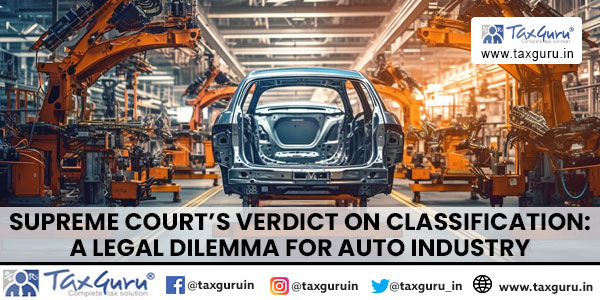1. Introduction
In a recent judgement involving M/s. SL Lumax Limited arising from the Westinghouse Saxby Farmer Ltd. case, the Hon’ble High Court of Madras emphasized the significance of the Harmonized System of Nomenclature (HSN) Explanatory Notes as an authoritative guide to classification. The court also cited Instruction No.01/2022-Customs dated 05.01.2022, directing assessing officers to consider both the facts presented by the assessee as well as the relevant Explanatory notes. This ruling has tried to settle considerable debate within the auto parts industry, especially in light of a July 5, 2023, Economic Times article titled “DGGI seeks Higher GST from Auto Parts Maker.” The article revealed shocking figures, indicating that the Directorate General of GST Intelligence (DGGI) had issued notices to 17 auto parts manufacturers, demanding taxes totalling approximately Rs 1200 crore. The above two events show how vital the Westinghouse judgement is and how it has changed the perspective of classifying goods With this article, we try to unveil the impact of the Landmark Westinghouse judgement on the Auto Parts Industry.
2. Background and facts of the Supreme Court Westinghouse Saxby Farmer Ltd. case
Classification of parts used in vehicles, aircraft, vessels, and associated transport equipment under the Customs law has always been an unsettled area.
a. In case of Westing house the issue involved was of classification related to ‘relays’ used in railways. These are electromagnetic device used for sending and receiving signals for controlling a circuit covered under Section XVII of Custom Tariffs.
b. The Appellant being a manufacturer of relays which was solely produced to be used as railway signalling equipment contended that the same needs to be classified under Chapter 86 Tariff heading No. 8608 which deals with Railway or tramway locomotives, rolling stock and parts thereof.
c. However, the revenue department presented a contradicting view stating the fact that the relay with the stated specification is already been classified under Chapter 85 tariff heading No.8536.90 which deals with Electrical machinery and equipment and parts thereof.
d. Considering the fact of the present case, the Hon’ble SC agreed to the contention of the appellant and ruled in favour of him stating that one should look for the principal use of those parts and accessories before classifying the same under a particular Chapter.
e. The department filed a review petition against the judgement of the Hon’ble SC, however the same has been dismissed.
f. Therefore, the said judgement has emerged as an exceptional one since the bench departs from the traditional interpretation methods emphasising the principal use of parts and accessories for classification.

3. Legal Complexities of the ruling
Legal complexities involved in the ruling and its impact on goods classification under the HSN system is as below:
i. Importance of following the hierarchy for interpretation of Customs Tariffs:
In the present ruling, the Hon’ble SC has taken a view by prioritising the 3rd Section note and disregarding the exclusion stated in clause (f) of the 2nd section note; however, it has already been established that one needs to classify particular goods under HS nomenclature in the following order:
Identify relevant section and chapter > Reviewing the section and chapter notes > Identify the heading > Reading Explanatory Notes > Considering relevant legal precedents > Applying General Rules of Interpretation.
Judgement: COMMISSIONER OF CENTRAL EXCISE, DELHI-III vs UNI PRODUCTS INDIA LTD. – 2020 (372) E.L.T. 465 (S.C.), wherein the Hon’ble SC emphasises that there is no reason to depart from the general trend of taking assistance of Explanatory notes to resolve the issue.
ii. Principle use vs Intended use
The Hon’ble SC relied upon the principle use of relay instead of intended use in the present case, The term “principle use” and “intended use” holds significant implications for the classification of goods.
“Principle use” refers to the purpose or motive for which the goods are being designed or manufactured whereas “Intended use” refers to the anticipated use of a particular goods. Principle use has narrow consideration as compared to the intended use.
Judgement: COMMISSIONER OF CENTRAL EXCISE, DELHI vs CARRIER AIRCON LTD. – 2006 (199) E.L.T. 577 (S.C.), wherein the Hon’ble SC has mentioned that the criteria of end use to which the product is put to cannot be used to determine the classification of Goods.
iii. If principle use is relied upon for classification, then half of the HSN classification entry would become redundant.
In the present case, the Hon’ble SC had a different perspective by taking principle usage/ end use as a key factor for classification. However other crucial factors such as specification, description and material used in manufacturing also serve as the foundation of classification. Thus, relying on sole end use would reduce the effectiveness of the HSN classification system and as an end result, half of the classification would become redundant or just vanish.
Judgement: SHIROKI AUTO COMPONENTS INDIA PVT. LTD. Vs COMMR. OF C. EX. & S.T., AHMEDABAD – 2020 (374) E.L.T. 433 (Tri. – Ahmd.) which the Hon’ble SC later affirmed, held that classification based on the principle use or end use would result in a specific entry to become redundant
iv. Generalia specialibus non-derogant
In the present case, the Hon’ble SC did not consider the specific exclusion as stated in the 2nd note to the section and relied upon the general note i.e. 3rd note to the section. Thus, the latin maxim of “generalia specialibus non-derogant” is relevant to the discussion in this article, particularly in the context of classifying goods under the HSN. The said Latin maxim translates to “the general does not detract from the special” and is often applied in legal interpretation to resolve conflicts between general and specific provisions.
Judgement: JTEKT SONA AUTOMOTIVE INDIA LIMITED VERSUS COMMISSIONER OF CUSTOMS – 2020 (371) E.L.T. 293 (Tri. – Del.) further maintained by the Hon’ble SC, held that goods need to be classified under a specific heading instead of general heading by applying General Rule of Interpretation.
4. Implication of the judgement on the Auto Industry
Now relying on the Westinghouse case, the DGGI has initiated inquiries demanding higher GST on parts and accessories at 28% stating the fact that these parts and accessories are solely or principally intended to be used with motor vehicles since the GST rate applicable on cars is 28% instead of a general rate of 18% based on their specific classification.
However, they have ignored that parts such as engine, windshield, car mate, seats, door handles, air filter etc. are specifically classified under the different chapters of the HSN.
Therefore, before taking the discussion further we shall take a glimpse of the related provision under GST law.
Understanding from the viewpoint of GST:
One needs to understand the fact that the department can not merely start charging 28% GST on parts and accessories taking the rate applicable to cars. Even to prove the contention of the department correct, they first need to classify this supply under either of the categories i.e. composite supply or mixed supply to charge 28% GST.
Let us understand both of them in conjoint with the trade practices followed in industry:
Section 2(30) of the CGST Act defines “composite supply” as
“(30) “composite supply” means a supply made by a taxable person to a recipient consisting of two or more taxable supplies of goods or services or both, or any combination thereof, which are naturally bundled and supplied in conjunction with each other in the ordinary course of business, one of which is a principal supply;
Why the supply is not covered under the category of composite supply:
The primary conditions imposed to classify any supply as composite supply is that the goods or services supplied are naturally bundled and supplied in conjunction in the ordinary course of business. In the Auto Industry generally, parts and accessories are supplied based on customer specifications which means a customer makes a demand of what parts and accessories they additionally require for their car and not in the ordinary course of business. Such demand can be before the purchase of the car, at the time of purchase of a car or subsequent to the sale. In all three scenarios, the said supply can not be treated as naturally bundled with the supply of cars in the ordinary course of business for the purpose of higher taxation. The Intent of the lawmaker is crystal clear stating that two or more taxable supplies, which are naturally bundled and supplies in conjunction can only be treated as composite supply which is not the present case.
Section 2(74) of the CGST Act defines “mixed supply” as
“(74) “mixed supply” means two or more individual supplies of goods or services, or any combination thereof, made in conjunction with each other by a taxable person for a single price where such supply does not constitute a composite supply;”
Why the supply is not covered under the category of mixed supply:
The Primary conditions imposed to classify any supply as mixed supply are goods or services or both provided are supplied together for a single price and the said supply does constitute a composite supply. The condition that the supplies do not constitute composite supplies is already explained above, however, the said supply does not even constitute a mixed supply since in the Auto Parts industry generally, the parts and accessories are invoiced separately from the sale of the car and even if it is invoiced together, they are valued at their respective value and not clubbed into the price of the car being sold. From the said, it makes clear that the condition of being supplied at a single price is not fulfilled in the present case.
Therefore, under GST law supply of parts and accessories and the supply of cars are distinct in nature and need to be treated as individual supplies instead of combining both of them.
5. Instructions issued by board to clarify the boiling issue
Considering these very facts, the CBIC issued Instruction No.01/2022-Customs dated 05.01.2022 wherein it was clarified that the classification of various parts of Section XVII is to be decided taking into account all facts, details of individual cases and then arrive at appropriate classification. It also restrains from wider applicability of the Westinghouse judgement unless the facts of the case are similar.
In the above circular, the Additional Solicitor General had opined that while assessing the classification of such parts all relevant aspects including HS explanatory Notes, relevant Section and Chapter notes along with applicable Supreme Court decisions shall be taken into consideration.
Another Instruction No.25/2022-Customs dated 03.10.2022 was issued where it upheld Instruction No.01/2022-Customs dated 05.01.2022 and stated instruction remains valid and does not require any changes.
The issuance of Instruction No.01/2022-Customs and Instruction No.25/2022-Customs by CBIC underscores the essential requirement for clear guidance in classification of goods, particularly in light of recent judicial pronouncements and evolving legal interpretations. These circulars serve as a response to the complexities and ambiguities encountered in the classification process, as highlighted in the article discussing the Supreme Court’s ruling and its impact on the auto industry.
6. Conclusion
The Hon’ble Supreme Court’s ruling in the Westinghouse case had opposing effects on two sectors, benefiting railway parts manufacturers while adversely impacting auto parts manufacturers. This ruling highlights the complexity involved in classifying goods, with no universal test applicable. Despite the legal weight of Supreme Court judgements, the need for a detailed analysis of individual cases remains paramount.
It is a legally settled principle that judgements are based on facts of individual cases and cannot be applied on adhoc basis and in this case to Auto Industry as the Supreme Court Judgement is specific to a part used exclusively in Railways.
The remedy to the situation is that the Auto parts manufacturers must conduct thorough assessments to ensure accurate classification under the HS code system, mitigating the adverse impacts of the ruling on their operations if any.
***
 Authors:
Authors:
Nitesh Jain, Chartered Accountant
Rishabh Jain, Article Assistant




